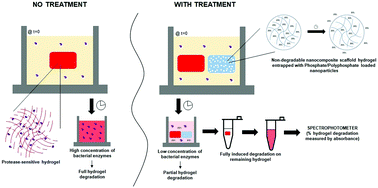当前位置:
X-MOL 学术
›
J. Mater. Chem. B
›
论文详情
Our official English website, www.x-mol.net, welcomes your
feedback! (Note: you will need to create a separate account there.)
An in vitro tissue model for screening sustained release of phosphate-based therapeutic attenuation of pathogen-induced proteolytic matrix degradation.
Journal of Materials Chemistry B ( IF 6.1 ) Pub Date : 2020-03-25 , DOI: 10.1039/c9tb02356a Marja B Pimentel 1 , Fernando T P Borges 2 , Fouad Teymour 2 , Olga Y Zaborina 3 , John C Alverdy 3 , Kuili Fang 2 , Seok Hoon Hong 2 , Austeja Staneviciute 1 , Yusheng J He 1 , Georgia Papavasiliou 1
Journal of Materials Chemistry B ( IF 6.1 ) Pub Date : 2020-03-25 , DOI: 10.1039/c9tb02356a Marja B Pimentel 1 , Fernando T P Borges 2 , Fouad Teymour 2 , Olga Y Zaborina 3 , John C Alverdy 3 , Kuili Fang 2 , Seok Hoon Hong 2 , Austeja Staneviciute 1 , Yusheng J He 1 , Georgia Papavasiliou 1
Affiliation

|
Tissue response to intestinal injury or disease releases pro-inflammatory host stress signals triggering microbial shift to pathogenic phenotypes. One such phenotype is increased protease production resulting in collagen degradation and activation of host matrix metalloproteinases contributing to tissue breakdown. We have shown that surgical injury depletes local intestinal phosphate concentration triggering bacterial virulence and that polyphosphate replenishment attenuates virulence and collagenolytic activity. Mechanistic studies of bacterial and host protease expression contributing to tissue breakdown are difficult to achieve in vivo necessitating the development of novel in vitro tissue models. Common techniques for screening in vitro protease activity, including gelatin zymography or fluorogenic protease-sensitive substrate kits, do not readily translate to 3D matrix degradation. Here, we report the application of an in vitro assay in which collagenolytic pathogens are cultured in the presence of a proteolytically degradable poly(ethylene) glycol scaffold and a non-degradable phosphate and/or polyphosphate nanocomposite hydrogel matrix. This in vitro platform enables quantification of pathogen-induced matrix degradation and screening of sustained release of phosphate-based therapeutic efficacy in attenuating protease expression. To evaluate matrix degradation as a function of bacterial enzyme levels secreted, we also present a novel method to quantify hydrogel degradation. This method involves staining protease-sensitive hydrogels with Sirius red dye to correlate absorbance of the degraded gel solution with hydrogel weight. This assay enables continuous monitoring and greater accuracy of hydrogel degradation kinetics compared to gravimetric measurements. Combined, the proposed in vitro platform and the presented degradation assay provide a novel strategy for screening efficacy of therapeutics in attenuating bacterial protease-induced matrix degradation.
中文翻译:

用于筛选持续释放的磷酸盐治疗减弱病原体诱导的蛋白水解基质降解的体外组织模型。
对肠道损伤或疾病的组织反应会释放促炎性宿主应激信号,引发微生物向致病表型的转变。其中一种表型是蛋白酶产生增加,导致胶原蛋白降解和宿主基质金属蛋白酶的激活,从而导致组织分解。我们已经证明,手术损伤会消耗局部肠道磷酸盐浓度,从而引发细菌毒力,而补充聚磷酸盐会减弱毒力和溶胶原活性。对导致组织分解的细菌和宿主蛋白酶表达的机制研究很难在体内实现,因此需要开发新的体外组织模型。用于筛选体外蛋白酶活性的常用技术,包括明胶酶谱法或荧光蛋白酶敏感底物试剂盒,不容易转化为 3D 基质降解。在这里,我们报告了体外测定的应用,其中在蛋白水解可降解的聚(乙二醇)支架和不可降解的磷酸盐和/或多磷酸盐纳米复合水凝胶基质的存在下培养溶胶原病原体。该体外平台能够量化病原体诱导的基质降解,并筛选持续释放的磷酸盐在减弱蛋白酶表达方面的治疗功效。为了评估基质降解与细菌酶分泌水平的函数关系,我们还提出了一种量化水凝胶降解的新方法。该方法涉及用天狼星红染料对蛋白酶敏感的水凝胶进行染色,以将降解的凝胶溶液的吸光度与水凝胶重量相关联。与重量测量相比,该测定能够连续监测水凝胶降解动力学并具有更高的准确性。 结合起来,所提出的体外平台和所提出的降解测定为筛选治疗药物在减轻细菌蛋白酶诱导的基质降解方面的功效提供了一种新策略。
更新日期:2020-03-26
中文翻译:

用于筛选持续释放的磷酸盐治疗减弱病原体诱导的蛋白水解基质降解的体外组织模型。
对肠道损伤或疾病的组织反应会释放促炎性宿主应激信号,引发微生物向致病表型的转变。其中一种表型是蛋白酶产生增加,导致胶原蛋白降解和宿主基质金属蛋白酶的激活,从而导致组织分解。我们已经证明,手术损伤会消耗局部肠道磷酸盐浓度,从而引发细菌毒力,而补充聚磷酸盐会减弱毒力和溶胶原活性。对导致组织分解的细菌和宿主蛋白酶表达的机制研究很难在体内实现,因此需要开发新的体外组织模型。用于筛选体外蛋白酶活性的常用技术,包括明胶酶谱法或荧光蛋白酶敏感底物试剂盒,不容易转化为 3D 基质降解。在这里,我们报告了体外测定的应用,其中在蛋白水解可降解的聚(乙二醇)支架和不可降解的磷酸盐和/或多磷酸盐纳米复合水凝胶基质的存在下培养溶胶原病原体。该体外平台能够量化病原体诱导的基质降解,并筛选持续释放的磷酸盐在减弱蛋白酶表达方面的治疗功效。为了评估基质降解与细菌酶分泌水平的函数关系,我们还提出了一种量化水凝胶降解的新方法。该方法涉及用天狼星红染料对蛋白酶敏感的水凝胶进行染色,以将降解的凝胶溶液的吸光度与水凝胶重量相关联。与重量测量相比,该测定能够连续监测水凝胶降解动力学并具有更高的准确性。 结合起来,所提出的体外平台和所提出的降解测定为筛选治疗药物在减轻细菌蛋白酶诱导的基质降解方面的功效提供了一种新策略。











































 京公网安备 11010802027423号
京公网安备 11010802027423号